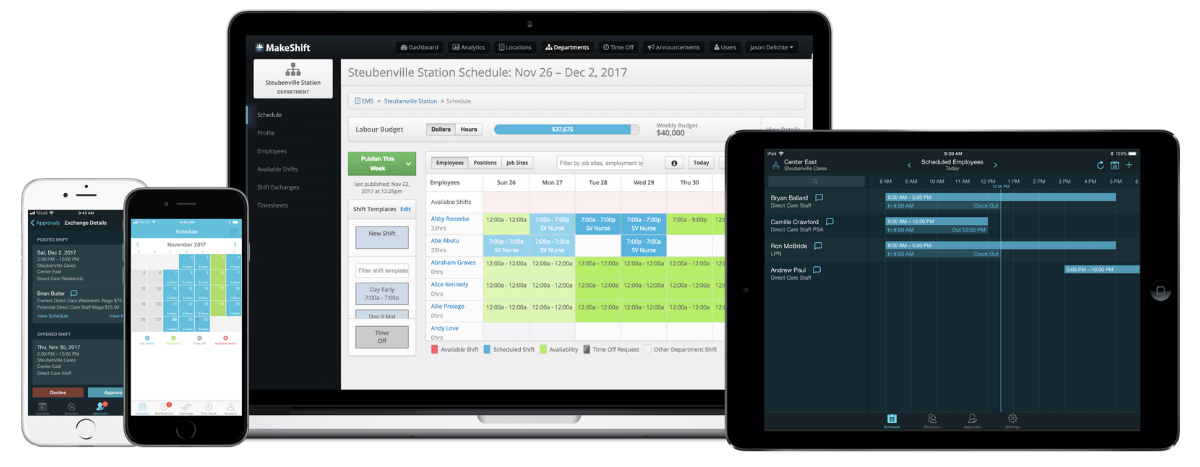Sam likes to dip out of work 15 minutes early to beat the evening rush hour. However, when he fills out his timecard, he always adds those 15 minutes to his workday hours.
It’s only 15 minutes.
True. But that 15 minutes adds up.
Unfortunately, timesheet fraud is common in today’s workplace.
And the reasoning behind it ranges from boredom and job insecurity to lack of oversight or being strapped for cash.
No matter the reason, it’s unethical, dishonest, and bad for business.
Not to worry, you can prevent timesheet fraud without becoming a full-time babysitter or micromanager.
Today, we’ll discuss how culture affects time theft and cutting-edge tools that make time tracking easy.
- What’s Timesheet Fraud & How Common Is It?
- Why Employees Commit Timesheet Fraud
- 5 Tips to Prevent Timesheet Fraud
- How to Talk to an Employee Who’s Committed Timesheet Fraud
- How MakeShift Can Squash TimeSheet Fraud
- Toss Timesheet Fraud Out on It’s Ear
What’s Timesheet Fraud & How Common Is It?
Timesheet fraud occurs when an employee falsifies hours on their timesheet. For example, an employee may regularly arrive at work 10 minutes late and knock off 10 minutes early but record a full day on their timesheet.
Seems harmless, right?
Until you do the math.
That’s 20 minutes a day X 5 days a week = 100 minutes each week.
400 minutes a month.
5,000 minutes a year (assuming they work 50 weeks/year).
Let’s say that employee makes $20 an hour. You’ll end up paying them about $1665.00 a year for time they didn’t work.
Unfortunately, time theft is common in today’s workplace.
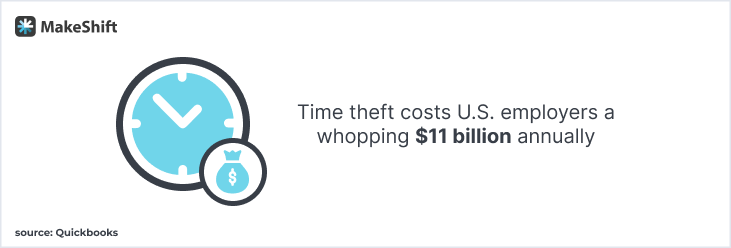
According to a QuickBooks survey, time theft costs U.S. employers a whopping $11 billion annually.
1/3 of employee fraud cases occur because companies lack internal controls.
A Software Advice survey found:
- 43% of employees commit time theft by padding their time cards
- 45% by recording inaccurate times
- 23% by buddy punching
The survey also found that one-quarter of employees falsely reported the time they’d worked between 76% and 100% of the time.
Unsurprisingly, timesheet fraud occurs much more frequently with manual time sheets than with time-tracking software that offers geo-fencing.
Why Employees Commit Timesheet Fraud
You might think money’s the only reason people fudge their timesheet numbers, but sometimes, it runs deeper than extra Benjamins.
Typically, bored, unhappy, unengaged employees are more likely to pad their work hours.
Of course, we’re not excusing time theft. However, read through these 6 reasons and the company culture checks to see if your company has areas in need of improvement.
- Money — The most obvious reason for committing timesheet fraud is to increase the amount of a paycheck.
✶ Culture check — Are you offering competitive compensation - Workload — Employees might inflate their work hours to appear more productive or as a result of unrealistic work expectations.
✶ Culture check — Are you setting unrealistic work goals? - Hiding Lateness or Absences — Some employees may falsify their timesheets to hide tardiness or unauthorized absences.
✶ Culture Check — Do you offer flexible work schedules to accommodate personal commitments? - Lack of Oversight — Employees may be more tempted to commit fraud in a workplace with little monitoring or enforcement of timekeeping policies.
✶ Culture Check — Can you increase oversight without affecting morale? - “Everyone Does It” — Employees might engage in timesheet fraud if they see their colleagues doing the same without facing consequences.
✶ Culture Check — Have you been open with your staff about how much money time theft costs and how it cuts into bonuses, company swag, or fun team events? - Job Insecurity — Employees worried about keeping their jobs might commit fraud to appear more valuable to the company.
✶ Culture Check — Are they right to fear losing their jobs? If not, maybe you need to do a better job of recognition.
5 Tips to Prevent Timesheet Fraud
The best way to handle time theft is to nip it in the bud. These 5 tips will help prevent timesheet fraud by cultivating a company culture that encourages responsibility, engagement, and integrity.
1. Implement automated time-tracking systems
Out of the 5 solutions listed here, this is the simplest and most effective. Using scheduling software that allows employees to use their phones to clock in and out can prevent buddy punching and timesheet fraud.

According to Finances Online, companies can eliminate daily lost productivity and recapture $666,400.00 in yearly wages by automating time tracking.
Automated scheduling solutions can also provide real-time data and analytics, helping you monitor work patterns and identify irregularities quickly. These systems often come with features like GPS tracking and biometric verification, further enhancing the accuracy and security of time tracking.
2. Establish clear policies & procedures
Create your time theft policy, then clearly communicate the consequences of timesheet fraud and the importance of accurate time reporting. You can implement a range of consequences like these:
- Termination — The most severe consequence is when the employee is fired for fraudulent behavior.
- Suspension without pay — Temporarily suspend the employee from work without pay for a certain period as a punishment.
- Warnings — Give written or verbal warnings about the behavior, with the understanding that repeated offenses will lead to more severe consequences.
- Restitution — Require the employee to repay any wages that were improperly obtained through timesheet fraud.
- Probation — Place the employee on probation, during which their behavior and time sheets are closely monitored.
- Demotion — In some cases, it makes sense to demote the employee to a lower position or reduce responsibilities due to their actions.
- Legal action — If the fraud is severe, take legal action against the employee, possibly resulting in criminal charges.
- Re-training — The employee undergoes training on proper timekeeping procedures and ethical conduct in the workplace.
Note: Make sure you run your company through the company culture checks above BEFORE resorting to these consequences.
3. Regularly audit timesheets
Conduct random audits to check for inconsistencies or patterns of fraud in these 3 ways:
- Random Spot Checks — Conduct random spot checks on timesheets to confirm the hours logged match the actual hours worked. This can involve comparing timesheets with security access logs, surveillance footage, or electronic login records to help verify.
- Cross-Verify with Project or Task Progress — For employees working on specific projects or tasks, compare their work progress with their logged hours. If there’s a significant discrepancy between reported hours and progress made, it could indicate timesheet fraud.
- Analyze Patterns & Trends — Use data analytics to identify patterns or trends in timesheet submissions that may indicate fraudulent behavior. For example, look for consistently rounded hour entries, excessive overtime claims, or repeated instances of logging hours during non-working days or hours.
The monitoring methods above work, but they’re awfully labor-intensive. You’d be much better off ditching manual timesheets for time-tracking software.
4. Develop a culture of honesty & transparency
Creating a culture of honesty and transparency where employees feel comfortable reporting discrepancies or concerns is crucial for maintaining integrity within your organization.
According to a Truth Decay study, 86% of employees want more truth, trust, and transparency at work.

Here are 3 ways to achieve this:
- Open Communication Channels — Establish clear and open communication channels where employees can report concerns without fear of retaliation. This could include:
- Anonymous reporting systems
- Regular one-on-one meetings with supervisors
- Dedicated hotlines for reporting unethical behavior - Leadership by Example — Lead by example by demonstrating honesty and transparency at all levels of management. When leaders uphold these values, they set a positive tone for your entire organization and encourage employees to follow suit.
- Training & Awareness Programs — Provide regular training and awareness programs to educate employees about the pillars of honesty and the negative impacts of falsifying timesheets. Emphasize your company’s commitment to ethical behavior and the channels in place for reporting concerns.
By prioritizing an environment where honesty is valued and employees feel safe speaking up, you can prevent timesheet fraud and promote a culture of integrity.
5. Offer flexible work schedules
If you offer schedule flexibility, employees are less likely to commit timesheet fraud, leading to more work-life balance and higher work efficiency.
Offer flexible work schedules in your company. Try these options and see how they work for your company’s workflow.
- Embrace remote working
- Hybrid work models
- Job sharing
- Offer flex hours instead of the traditional 9-to-5 work week.
Flexibility in the workplace also includes encouraging employees to take breaks and time off to avoid burnout. This leads to healthier, more engaged employees less apt to commit time theft.
How to Talk to an Employee Who’s Committed Timesheet Fraud
You may feel betrayed and even angry when you discover an employee falsifying their timesheet.
And rightly so.
But it’s best to check your emotions (and your ego) at the door before you broach the subject with them.
Your goal is to have a calm, two-way conversation about the time theft and possibly find out WHY they inflated their work time. Hopefully, you’ve already laid out the time theft policy and the possible consequences.
This conversation is about coming clean, handing down consequences, and, if feasible, moving forward.
- Take a sensitive approach — Acknowledge the seriousness of the issue while remaining calm and professional.
- Present the evidence — Clearly outline the discrepancies found and show the evidence supporting the fraud claim. Remember: Don’t get into a back-and-forth argument here. Let the proof do most of the talking.
- Ask WHY — This step can help you gauge your employee’s character and, possibly, the state of your company culture. It’s important to do this step before doling out consequences — this demonstrates compassion and may determine consequences depending on their response.
If the employee gets defensive and plays the blame game, this might reveal a person who resists accountability. However, flexibility could be the solution if the employee shows remorse and shares about school drop-off and pick-up conflicting with their work schedule. - Discuss consequences — Explain the potential disciplinary actions and which consequences they’ll be reaping for their actions.
- Offer a path for rectification — Depending on the severity, offer options for the employee to rectify the situation, like repaying overpayments.
- Ensure clear communication & documentation — Document the conversation and any agreed-upon actions for future reference.
How MakeShift Can Squash TimeSheet Fraud
MakeShift goes beyond staff scheduling by including features that streamline employee management and encourage team cohesiveness.
We’ve designed our time and attendance solution to help reduce time theft and enhance work life with these features:
Easy Clock-In — Accurately track employee time when they clock in and out from their phones or an on-site device. Use geofencing to ensure employees are on-site when clocking in and out for shifts and breaks.
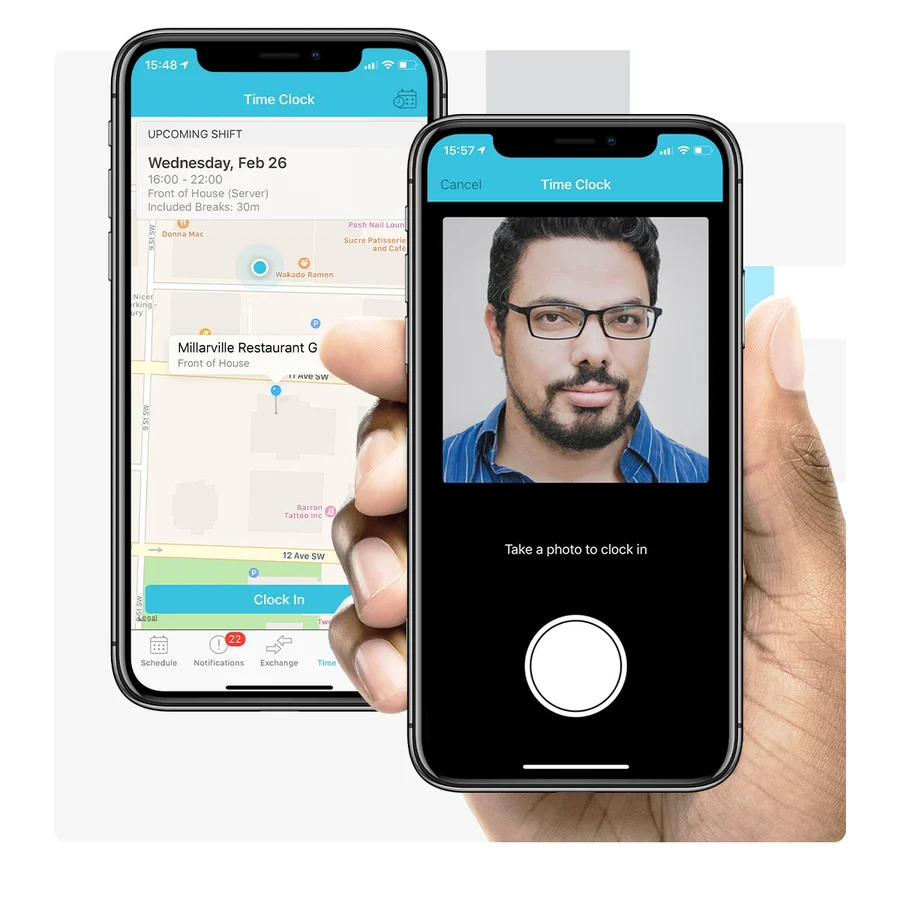
- Quickly clock in from the mobile app.
- Prevent buddy punching by using employee photos to clock in.
- Geo-fencing prevents clocking in until employees are on-site.
Accurate Timesheets — Manage employee timesheets based on clock-in and out entries. Quickly approve, export to payroll, and you’re done.
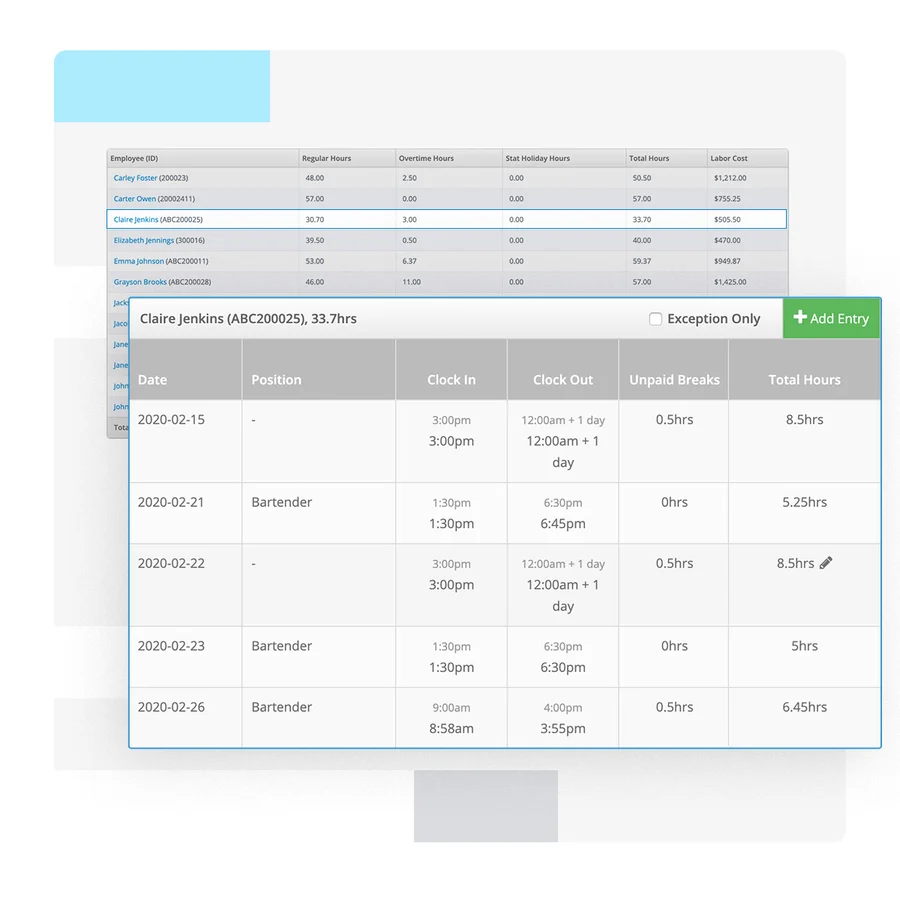
- Ensure accuracy by approving and closing out timesheets.
- Wages are calculated automatically based on payroll rules.
- Payroll automatically exports to your payroll provider, increasing accuracy.
Manage-on-the-go — With MakeShift Live, our manager mobile app, you can quickly see who’s on shift or on a break and easily adjust time entries if needed.
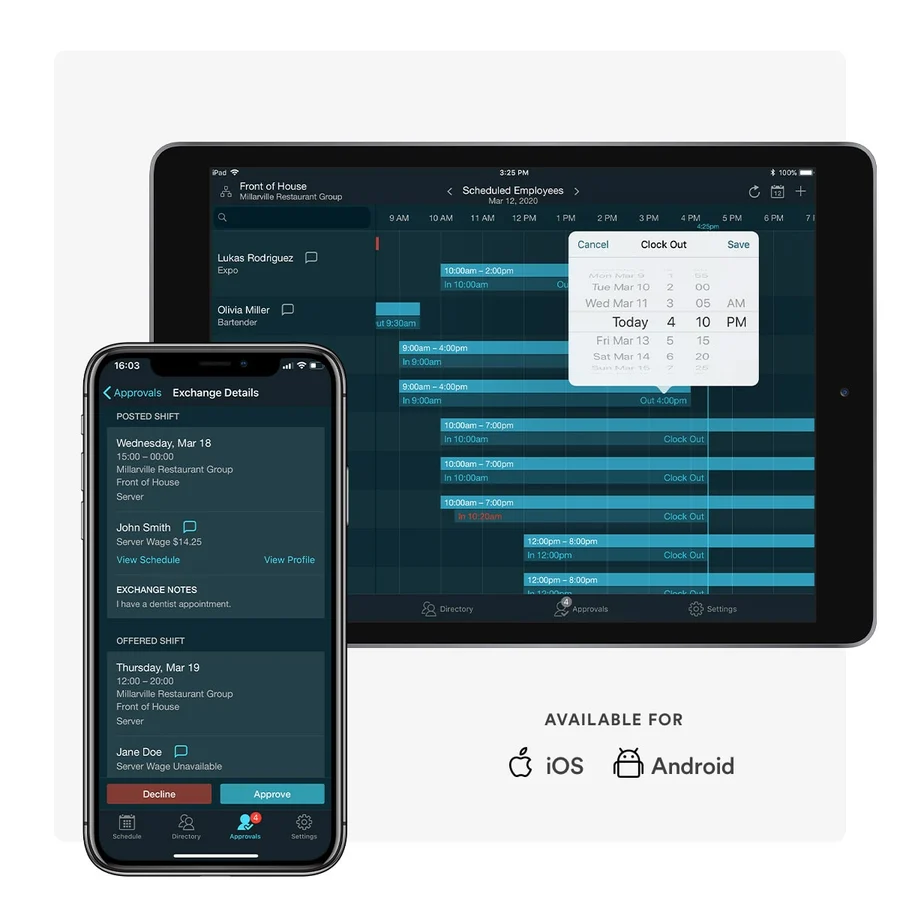
- Access the daily schedule view of shifts compared to clock-ins right from the app.
- Easily adjust employee time entries on the go.
- You can quickly see who’s working and who’s out.
In addition to easy time-tracking, MakeShift offers automated scheduling that makes scheduling a breeze.
Toss Timesheet Fraud Out on It’s Ear
Yes, in business, the struggle against time theft is real. But it doesn’t have to be a struggle.
Replacing manual timesheets with a smarter, digital time-tracking tool takes you out of the babysitter role and empowers your employees to take responsibility for their work roles.
At MakeShift, we believe in helping you reclaim your time and support your staff through comprehensive workforce management. Ready to test drive our scheduling and time-tracking software? Schedule a FREE demo today.




